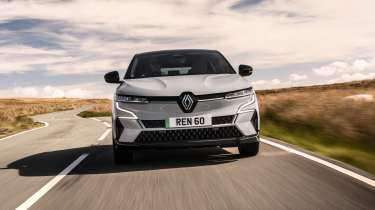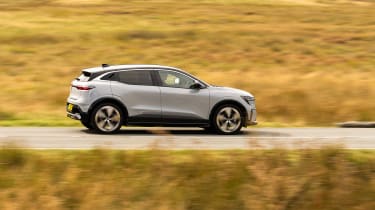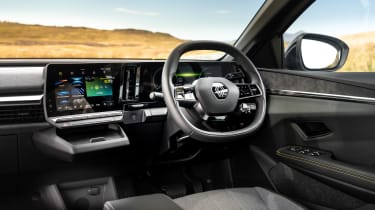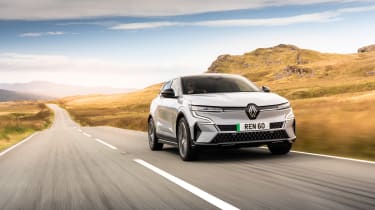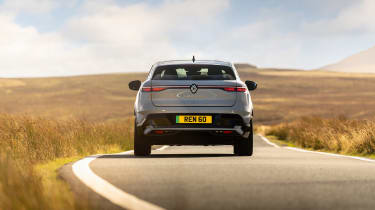Renault Megane E-Tech 2022 review
Renault’s new all-electric Megane drives well and looks smart, but doesn’t have much of a distinctive personality
Like many mainstream manufacturers, Renault has felt the full force of the market’s changing economies, whether that be the squeeze of its key segments or the pressure to electrify. To address both of these problems in the midsize hatchback class, Renault’s made the bold decision to replace its traditional Megane with an all-new and electric-only replacement called the, erm, Megane.
Familiar moniker aside, the new Megane E-Tech, to give it its full name, is a bespoke pure-EV that’s not at all related to the previous combustion-powered hatchback. This also means the death of the Renault Sport Mégane, but we’re assured that future hot Renaults are still very much in the product plan, only wearing Alpine badges this time around.
For now, look past Megane E-Tech’s quasi-SUV styling and proportionally large wheels and you’ll note that it’s actually smaller than the last Megane, sitting around 130mm shorter, offset with only small upticks in width and height.
Being a new-generation EV it sits on a platform that, like many of this ilk, mounts the battery pack under the cabin and between the axles. For now, there’s just the one capacity available – 60kWh – which is equivalent to mid-level rivals from Volkswagen and Cupra. Unlike the VW Group cars, though, Renault has mounted the electric motor on the front axle, making the Megane E-Tech front-wheel drive and giving it a more traditional driving position than the almost van-like ID.3.
More reviews
In-depth reviews
Reviews
- Renault Sport Mégane R26.R (2008 - 2009) review – Dieppe's finest hour
- Renault Megane RS 300 2021 review – less is more with this GTI rival
- Renault Megane RS sport chassis (2017-2020) review – forget the Trophy, basic is best with the Megane RS
- Renault Megane RS Trophy (2019-2020) review – is this Renault Sport’s redemption?
- Renault Megane RS cup chassis (2018-2020) review – sharp, even when you don't want it to be
- K-Tec Racing Mégane review
The electric motor produces a maximum of 217bhp, and drives the front wheels via a single-speed transmission. Performance is average for the type, the E-Tech reaching 62mph in 7.5sec, which is about a second behind an equivalently powered Cupra Born 230 (as fitted with the equivalent 58kWh battery). Objectively, though, the Megane feels just as quick as the Cupra with plenty of roll-on acceleration – it’s only the initial take-off that feels a little more muted.
The rest of the dynamic package isn’t particularly groundbreaking. It features MacPherson struts up front, a multi-link rear end and passive dampers, and despite the large 20-inch wheels the eco-focused Goodyear tyres still have a decent 40-section profile to them. Entry-level models reduce this wheel size down to 18 inches. Of course, the sticky situation of weight is always a consideration when talking about EVs, and the Megane’s 1708kg figure is about right considering its size and battery capacity.
Jump into the cabin and you’re greeted with a big leap in design and material quality for Renault. It feels more than a generation ahead of the last Megane, with large and bright high-resolution displays, a retention of some physical buttons and lots of interesting materials. A VW ID.3 by comparison feels sparse, with confusing interfaces and awkward ergonomics. You can also hunker down into the Megane’s cabin, as its high scuttle and windowline make it feel more like a normal hatchback than its rivals.
This gives the Megane an instantly relatable driving impression on the road, with a starter button and Mercedes-like column-mounted gear selector contrasting against the ‘get-in-and-drive’ experience of many modern EVs. Getting underway, the throttle pedal is quite long in its Normal driver mode, making it feel a touch laborious on take-off. But once you acclimatise it’s a very easy car to drive smoothly, with intuitive calibration to both the throttle and brakes. There’s four levels of brake regen available selected through paddles on the steering wheel, but even on its maximum setting there’s not quite enough built-in regen to bring the car to a complete stop without needing to hit the brake pedal. Select Sport mode and the Megane feels much more lively, with a much sharper throttle pedal and more generous power delivery from the motors. Only in this mode does the Megane feel its 218bhp.
There’s a definite firmness to the suspension, but it’s never to the point of harshness. The Megane controls its body well and seems happy to lean into its suspension travel, with both axles having no trouble dealing with undulations or challenging cambers. A relatively fast steering rack helps give the Megane an impression of agility, and comes with a nice bit of resistance in Sport mode, too. Renault also offers an individual or ‘Perso’ mode, which allows you to configure the variable throttle, steering and regenerative braking settings to your liking.
Ultimate grip is conservative – you can thank those eco-focused Goodyears – but when the Megane does start to reach its limits the chassis exhibits a nice balance. In fact, unlike the VW Group rivals that call a halt on any form of enthusiastic driving, you can enter corners at speed, come off the throttle and feel the body neutralise as the weight equalises between the axles. It’s not exactly a Mégane RS of the previous generation, but there’s a definite polish to the chassis, feeling more resolved than most other mainstream EVs. It’ll even let you disengage the traction control. Get greedy with the throttle and the front wheels will scrabble and chirp in Sport mode thanks to the instant torque from the electric motor.
While most of its intended customer base won’t care about its ultimate handling, the dynamic package still feels considered and well executed – something that can’t really be said for the VW ID.3 or Cupra Born.
Prices and rivals
The Megane E-Tech isn’t cheap, starting at just under £37,000, but doesn’t extend much beyond that price, peaking at £40,995 for the fully loaded launch edition. It’s also worth noting that it’s largely the same price as rivals from Cupra and VW, with the 58kWh models also costing from around £37,000 and rising to well above £43,000. It is worth noting, though, that due to their more condensed packaging, the VW Group rivals are more spacious inside.
Kia’s Niro EV is another potential rival that has a slightly bigger battery yet similar price point, while the Citroën ë-C4 is less expensive but comes with a smaller battery. Looking at premium options, BMW’s new iX1 (effectively a replacement for the now-dead i3) is more expensive, but comes with a BMW badge. In any case, no midsize hatchback-replacing EV portrays much in the way of an enjoyable driving experience, and for now the Megane doesn’t do much to change the status quo, but that doesn’t mean to say it comes without potential.

